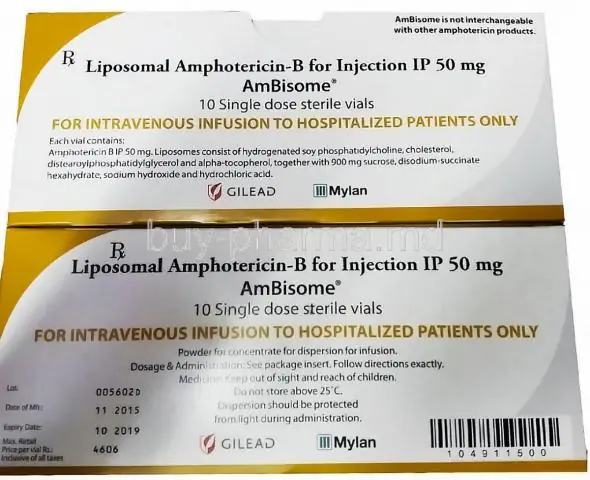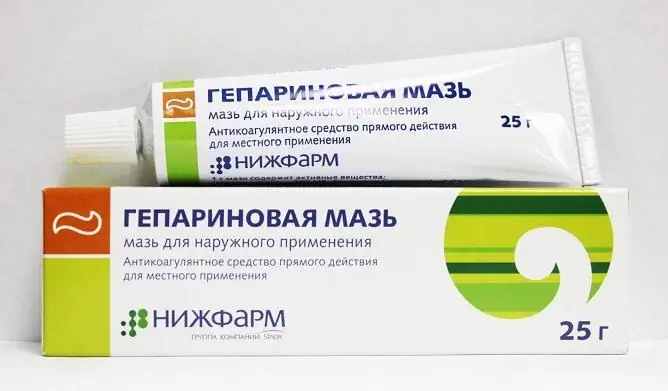- Author Rachel Wainwright [email protected].
- Public 2023-12-15 07:39.
- Last modified 2025-11-02 20:14.
Amphotericin B
Latin name: Amphotericin B
ATX code: J02AA01
Active ingredient: amphotericin B (amphotericin B)
Producer: Sintez, JSC (Russia)
Description and photo update: 2019-23-08
Prices in pharmacies: from 30 rubles.
Buy

Amphotericin B is a broad spectrum antifungal antibiotic medication.
Release form and composition
Amphotericin B comes in the following forms:
- lyophilisate for the preparation of a solution for infusion and inhalation: a yellow hygroscopic porous mass, practically odorless, containing 50,000 IU of the active substance of the same name in 1 vial (in 10 or 20 ml vials, 1, 5 or 10 bottles);
- ointment for external use: homogeneous, yellow, with a content of 1 g of 30,000 IU of the active substance of the same name (in aluminum tubes of 15 and 30 g, in a carton pack of 1 tube).
Excipients in the lyophilisate: sodium deoxycholate (deoxycholic acid, sodium hydroxide), sodium phosphate disubstituted 12-aqueous (sodium hydrogen phosphate dodecahydrate).
Excipients in the ointment: vaseline oil, polysorbate 80, medical petroleum jelly.
Pharmacological properties
Pharmacodynamics
Amphotericin B is a polyene macrocyclic antibiotic with antifungal activity. Streptomyces nodosus is produced.
Depending on the sensitivity of the pathogen and the concentration of the substance in biological fluids, it has a fungicidal or fungistatic effect. It binds to ergosterols (sterols), which are located in the cell membrane of the fungus sensitive to the action of the drug. As a result, there is a violation of the membrane permeability, the release of intracellular components into the extracellular space, followed by lysis of the fungus.
When administered by infusion, it is active against most of the strains of Histoplasma capsulatum, Candida spp., Paracoccidioides brasiliensis, Aspergillus fumigatus, Coccidioides immitis, Blastomyces dermatitidis, Sporothrix schenckii, Absidia Ranopus spp., Rhizoppos. Mucor mucedo.
Moderate activity is observed in relation to some of the simplest: Leishmania mexicana, Leishmania braziliensis, Naegleria fowleri.
Fusarium spp. Are generally resistant to amphotericin B. and Pseudallescheria boydii.
When applied externally, it is active against Candida spp., Including those resistant to the action of other antifungal agents.
Amphotericin B in any dosage form is ineffective against rickettsia, bacteria and viruses.
Pharmacokinetics
Infusion solution
In the blood after a single intravenous injection of the substance, an effective concentration is created (it is dose-dependent), which remains for 24 hours.
C max (maximum concentration of the substance) in plasma after intravenous administration of 1-5 mg per day is 0.000 5-0.002 mg / ml. It binds to plasma proteins by more than 90%.
Amphotericin B is distributed in the kidneys, liver, adrenal glands, lungs, spleen, muscles and other tissues. Concentrations in aqueous humor, pleural effusion, synovial and peritoneal fluids - about 2/3 of the plasma concentration; in the cerebrospinal fluid, the substance is usually not detected.
Apparent volume of distribution: adults - 4 l / kg, children - 0.4-8.3 l / kg, newborns - 1.5-9.4 l / kg.
Metabolic pathways are unknown. In urine and bile, approximately 98% is present in the form of metabolites. It is excreted by the kidneys slowly.
Initial half-life: adults - 24 hours, children - 5.5-40.3 hours, newborns - 18.8-62.5 hours. The terminal half-life is 15 days. Cumulates poorly, despite delayed elimination.
It is practically not excreted during hemodialysis. After the end of the application, it is found in the body for several more weeks.
Ointment for external use
Amphotericin B is not absorbed and has no systemic effect.
Indications for use
Inhalation and parenteral administration of Amphotericin B is indicated:
- candidiasis of internal organs;
- candidiasis of the gastrointestinal tract, intestinal candidiasis;
- coccidioidosis and paracoccidioidosis;
- chronic granulomatous and disseminated candidiasis;
- histoplasmosis;
- disseminated cryptococcosis, cryptococcal meningitis (or caused by other fungi);
- chromomycosis;
- zygomycosis (phycomycosis);
- North American blastomycosis;
- aspergillosis (disseminated and invasive);
- mold mycosis;
- endocarditis;
- fungal infections of the urinary tract;
- disseminated sporotrichosis.
Ointment Amphotericin B is prescribed for the treatment of candidiasis of the skin and mucous membranes.
Contraindications
Lyophilisate for preparation of solution for infusion
Absolute:
- chronic renal failure;
- lactation period;
- individual intolerance to the components of the drug.
Relative (Amphotericin B is prescribed under medical supervision):
- kidney disease (including glomerulonephritis);
- anemia;
- amyloidosis;
- cirrhosis of the liver;
- hepatitis;
- diabetes;
- agranulocytosis;
- pregnancy.
Ointment for external use
- severe liver dysfunction;
- neonatal period (28 days);
- pregnancy and lactation;
- individual intolerance to the components of the drug.
Instructions for the use of Amphotericin B: method and dosage
Lyophilisate for the preparation of infusion and inhalation
Before the intravenous administration of Amphotericin B, the exact weight of the patient is established and the required dose is calculated at the rate of 250 U / kg. To determine individual tolerance, 100 U / kg is first administered, and in the absence of side effects, the dose is gradually increased to 1000 U / kg.
To avoid cumulation, the medication is administered 1-2 times a week or every other day.
The duration of the treatment course is determined by the severity and localization of the disease, and, as a rule, is not less than 1-2 months. The total course dose of the medication is 1.5-2 million units, the treatment is repeated after a month.
Inhalation is carried out 1-2 times a day for 15-20 minutes, 10 ml per procedure, which corresponds to a daily dose of 1000-2000 U / kg of patient's body weight. The duration of treatment is 10-14 days, after a week the course can be repeated.
The solution is prepared immediately before use by dissolving the contents of the vial in the amount of 50,000 IU in 10 ml of water for injection.
Ointment
Ointment Amphotericin B is applied in a thin layer to the affected skin 2-4 times a day. The treatment course depends on the indications:
- candidiasis of skin folds - 1-3 weeks;
- diaper rash in children - 1-2 weeks;
- paronychia and interdigital lesions - from 2 to 4 weeks.
Side effects
With inhalation and parenteral use of the drug, the following may occur: nausea, epigastric pain, deterioration of appetite and vision, vomiting, leukopenia, anemia, headache, diplopia, polyneuropathy, arrhythmia, hypertension, azotemia, hypokalemia, proteinuria, acidosis, edema, rash Quincke, bronchospasm, contact allergic dermatitis, runny nose, sore throat, cough, chills, fever.
Topical application of Amphotericin B ointment may cause tingling, dryness, burning, and redness of the skin.
Overdose
The main symptoms when using the infusion solution: respiratory and cardiac arrest.
Therapy: symptomatic. Monitoring of renal and liver function, respiratory and cardiac activity, peripheral blood picture and electrolyte content is required; supportive treatment. It is not removed during hemodialysis. Before resuming the administration of Amphotericin B, the patient's condition must be stabilized.
There is no information on overdose with external use of the drug.
special instructions
Therapy should be discontinued if anemia develops.
Ointment under occlusive dressings should not be used.
During treatment, you should systematically monitor the picture of peripheral blood, kidney and liver function.
If after 1-2 weeks the effect of Amphotericin B is insufficient, you should consult your doctor for a more precise treatment regimen.
Application during pregnancy and lactation
- infusion solution: during pregnancy, the use of the drug requires medical supervision; therapy is contraindicated during lactation;
- ointment: not prescribed during pregnancy / lactation.
Pediatric use
For children, Amphotericin B is given as an infusion solution in the lowest effective dose.
Amphotericin B ointment is contraindicated in newborns (28 days).
With impaired renal function
Infusion solution:
- chronic renal failure: therapy is contraindicated;
- kidney disease (including glomerulonephritis): Amphotericin B should be used under medical supervision.
For violations of liver function
- infusion solution: for hepatitis and liver cirrhosis, the drug is prescribed with caution;
- ointment: therapy against the background of severe liver dysfunction is contraindicated.
Drug interactions
According to the instructions, Amphotericin B is pharmaceutically incompatible with sodium solution 0.9% and other solutions containing electrolytes, as well as with heparin.
When taken simultaneously, the effect and toxicity of sulfonylurea and theophylline preparations, anticoagulants, flucytosine (its half-life is lengthened) increases, when taken with ethinyl estradiol, its effect decreases, and the risk of breakthrough bleeding increases.
Non-narcotic analgesics, cimetidine, antidepressants and other inhibitors of microsomal liver enzymes reduce the metabolic rate, increase the toxic effect, increasing the concentration in the blood serum.
Rifampicin, carbamazepine, phenytoin, barbiturates and other inducers of microsomal liver enzymes accelerate metabolism, thereby reducing the effectiveness of the drug.
Curariform muscle relaxants and cardiac glycosides increase the toxic effect, and carbonic anhydrase inhibitors, glucocorticosteroids and adrenocorticotropic hormones increase the risk of hypokalemia. If it is necessary to jointly prescribe the drug with glucocorticosteroids and corticotropin, the electrolyte composition of the blood and ECG should be monitored (in order to avoid the development of hypokalemia and arrhythmias).
The risk of developing renal dysfunction increases with the simultaneous administration of aminoglycosides, pentamidine, cyclosporine and other nephrotoxic drugs with Amphotericin B, therefore their combined use is prohibited.
When prescribing radiation therapy, anticancer drugs and drugs that suppress bone marrow hematopoiesis, the risk of developing hematological disorders, including anemia, increases. In addition, anticancer drugs increase bronchospasm and cause a decrease in blood pressure (blood pressure).
Caution is advised to combine treatment with imidazoles such as itraconazole, miconazole, fluconazole, ketoconazole, clotrimazole to avoid the development of amphotericin B resistance.
Analogs
Analogs of Amphotericin B by the mechanism of action are drugs such as Ambizom, Amphoglucamine, Amphocyl, Ampholip.
Terms and conditions of storage
Shelf life of lyophilisate is 4 years, ointments - 2 years (provided they are stored, taking into account the manufacturer's recommendations: lyophilisate - at a temperature of 2-10 ° C, ointment - up to 4 ° C).
Terms of dispensing from pharmacies
Amphotericin B in all dosage forms is available as directed by a physician.
Reviews of Amphotericin B
Reviews of Amphotericin B are few. The drug in the form of an infusion solution is used in stationary conditions. Its effectiveness is assessed as high.
Price for Amphotericin B in pharmacies
The approximate price for Amphotericin B (lyophilisate, 1 bottle of 10 ml) is 31-37 rubles.
Amphotericin B: prices in online pharmacies
|
Drug name Price Pharmacy |
|
Amphotericin B 50 thousand units lyophilisate for preparation of solution for infusion 10 ml 1 pc. RUB 30 Buy |

Maria Kulkes Medical journalist About the author
Education: First Moscow State Medical University named after I. M. Sechenov, specialty "General Medicine".
Information about the drug is generalized, provided for informational purposes only and does not replace the official instructions. Self-medication is hazardous to health!






